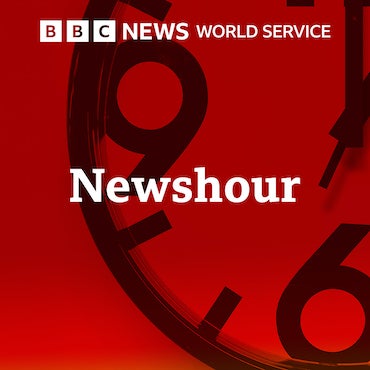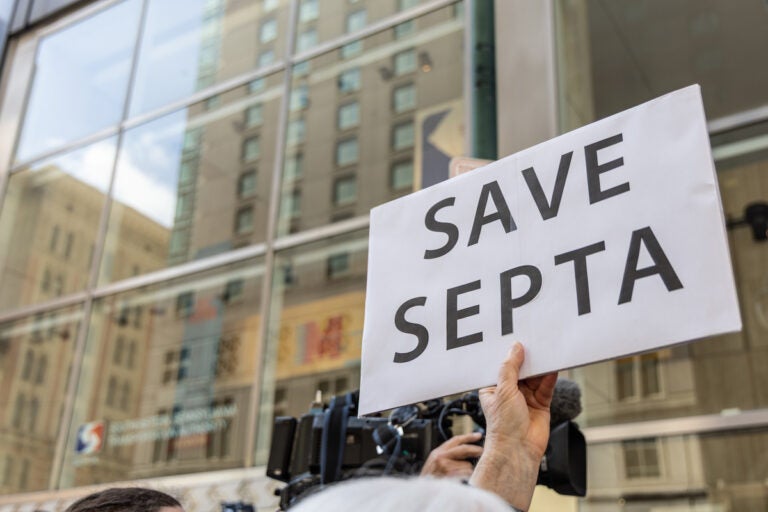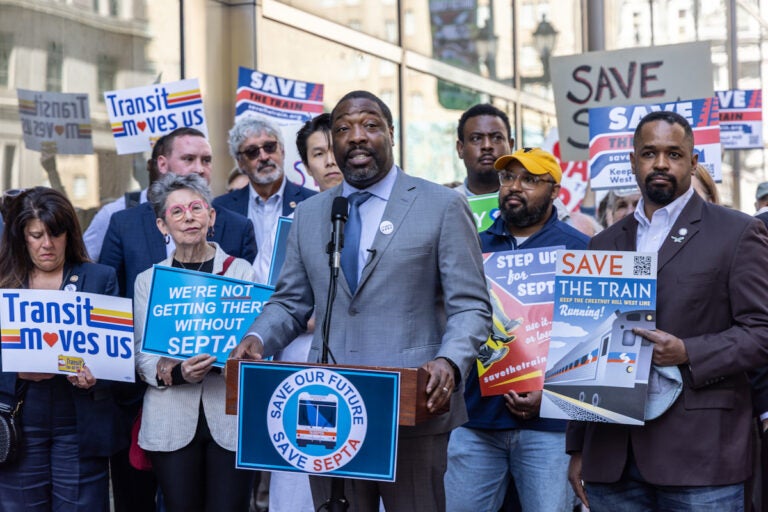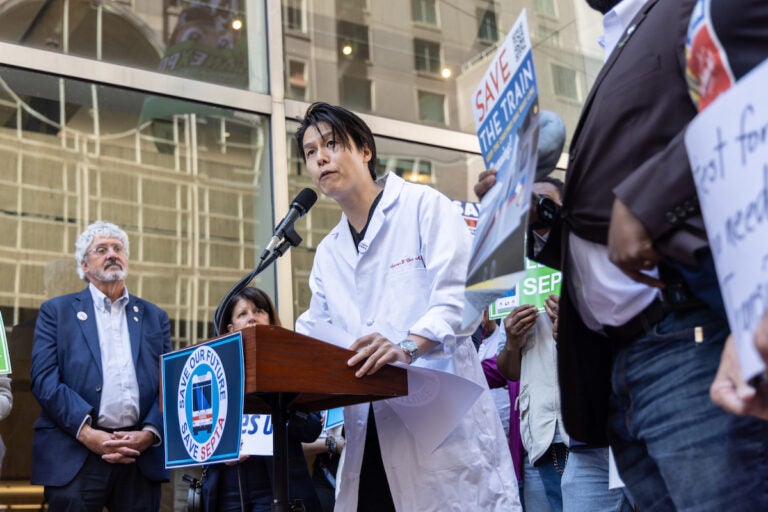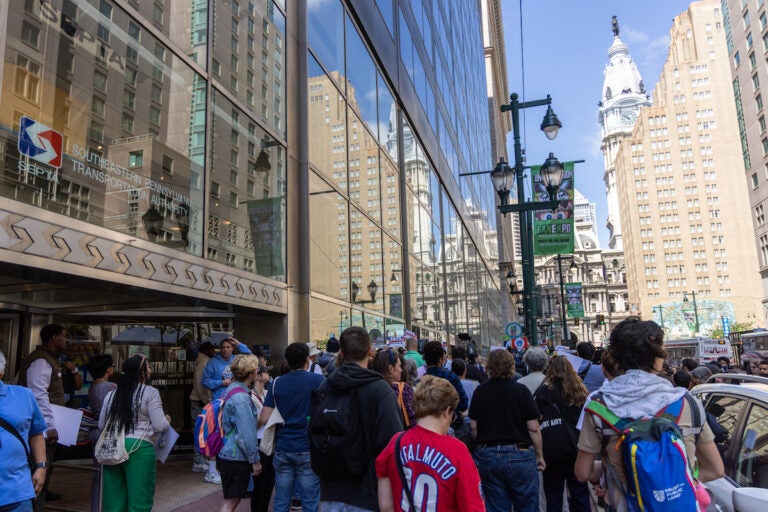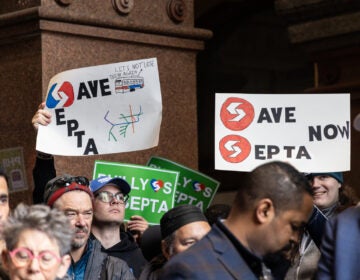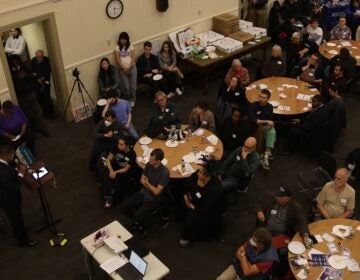SEPTA board pressed for answers over proposed cuts: ‘Are people just supposed to walk?’
Advocates rallied to support state subsidies for SEPTA and worry about public transportation for the most vulnerable riders, like students, seniors and disabled passengers.
Listen 0:54
Public transit supporters rallied for SEPTA outside their headquarters on Market Street on May 19, 2025. (Kimberly Paynter/WHYY)
Have a question about Philly’s neighborhoods or the systems that shape them? PlanPhilly reporters want to hear from you! Ask us a question or send us a story idea you think we should cover.
Dozens of SEPTA riders shared with the public transportation agency’s board about how service cuts would affect their lives — and in some cases leave them with few options — during the first round of public hearings inside SEPTA’s headquarters on Monday.
SEPTA needs to fill a $213 million structural budget deficit. Its total taxpayer subsidy is closer to $1.2 billion.
But there’s been significant Senate Republican pushback against more public funding for SEPTA.

West Chester University student Bonita Ty said she relies on the suburban buses for work, school and errands.
“I take the bus everywhere,” Ty said during the hearing.
She knows exactly what it means to walk in the Philadelphia suburbs along roadways not designed with pedestrians in mind.
For example, when she missed a 204 bus, which would have been a 20-minute bus ride to the grocery store, she started walking the 6-mile trek.
“I have walked from Exton Square Mall to Giant in Malvern just because the bus wasn’t there,” Ty said.
The 204 bus is contracted out by SEPTA as a suburban route. It would be eliminated by August 2025 due to low ridership of fewer than 300 passengers each day. The bus has about five passengers each hour and costs $23 per passenger to operate, according to SEPTA performance data.
“What do we do? Are people just supposed to walk up Lancaster Avenue?” Ty asked. “We’re left without any alternative.”
For years, Mount Airy resident Leah Batchis commuted into Center City for work each day on SEPTA. Now she travels on the Chestnut Hill West train for events and leisure activities like shopping.
The Chestnut Hill West train has on average 20 passengers per hour, and it costs $19.60 per passenger to operate it, according to SEPTA route performance data.
SEPTA spends $65 million annually to lease Amtrak-owned tracks that carry riders on the Paoli-Thorndale, Chestnut Hill West, Trenton, Wilmington-Newark and Cynwyd Regional Rail lines.
In 2026, all of those train lines would be suspended under SEPTA’s budget proposal.
Batchis worries about how her children might get to class if that train stops running. SEPTA serves about 63,000 public school students each year.

While her daughter graduated from high school this year, her son is in eighth grade.
“I’m very concerned. We need a transit system to move people around,” Batchis said. “SEPTA is on time something like 90% of the time, the Regional Rail. Of course, you’re going to remember the time when it was delayed, but it really is a fantastic system.”
In August 2024, SEPTA’s Regional Rail trains were on-time 87% of the time. In January, it was on-time 81% of the time.
“I believe that SEPTA has become much more responsive to rider concerns but they can only do this if they have funding to maintain all of the aging facilities that they have,” she said.
Suzanne Hagner, who relocated to Philadelphia from the West Coast when she retired, regularly takes her bicycle on SEPTA.
“I much prefer it to driving and it gets me down here [into Center City] faster than if I’m sitting in my car on the expressway,” she said. “Sometimes I’ll just ride into the city and then I’ll put my bike on one of the buses to go back home. It’s really clean and good exercise.”
Hagner was ecstatic when SEPTA invested $45 million for an improved Wissahickon Transportation Center in her neighborhood two years ago.
It included a new express bus that would connect Frankford Transportation Center and Wissahickon Transportation Center via Roosevelt Boulevard to connect Northwest and Northeast Philly. But now, she’s worried about the integrity of the system, let alone any expansion efforts.
“I don’t think that [express bus] will happen now,” she said.
Before the hearing, advocates rallied in front of SEPTA’s headquarters in Center City.
Philadelphia’s Democratic delegation spoke to public transit supporters about their efforts to sway more Republicans in Pennsylvania’s split legislature.
State Rep. Joseph Hohenstein introduced legislation with Rep. Ben Waxman to enable counties to levy three new taxes to support public transportation, such as a real estate transfer tax, an income tax and a sales tax.
It would include Allegheny, Bucks, Chester, Delaware, Lancaster, Montgomery and Philadelphia counties but would require local ordinances to go into effect. The bill has not been heard yet in committee.
The idea is that local communities could get matching federal transportation funding with the new taxes, Hohenstein said.
“If we pass that bill we’re not going to just see filling a gap like we did last year with flex funding from the governor,” he said. “What we’re going to see is a regular source of income every year for transit and for the infrastructure.”

Subscribe to PlanPhilly
WHYY is your source for fact-based, in-depth journalism and information. As a nonprofit organization, we rely on financial support from readers like you. Please give today.

